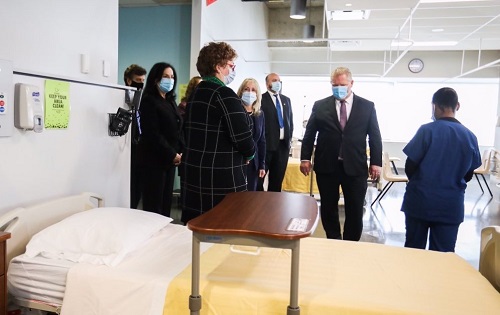Student Simulations

Michael Eliadis, a recent graduate of the MA in Education Program, has completed his research on the effects of simulation when developing professional identity and self-efficacy in pre-licensure nursing students. Traditionally, nursing students complete their training in hospitals and labs before graduating to join the work force. However, placing student nurses can be difficult at times, and these in-hospital experiences frequently only emphasize knowledge of the most average experiences of nursing. Eliadis found that high-fidelity, incredibly realistic, simulations serve many of the same benefits as in hospital experiences when it comes to building confidence and self-efficacy.
Being able to conduct simulations as a replacement to some of the in-hospital lab time allows students to learn in a psychologically safe environment, which in turn can allow them to feel safer and more comfortable with taking action to implement their knowledge. In simulations, the principle is “do no harm, however if you put your patient at risk, it is okay, as it will be corrected and we’re going to debrief it,” says Eliadis. Situations in which failure without fear of harm is an option can be highly beneficial to students who are starting out in the nursing field.
Due to COVID-19, there are soon-to-be nursing graduates who haven’t had many chances to work with actual patients. These high-fidelity simulations help to build the confidence of nursing students and help them feel less anxious when they actually begin to work, Eliadis explains. “There’s a lot of intimidation and anxiety as a student going and actually caring for a real human being,” he says, explaining how simulations help students learn to be more confident in their knowledge and abilities as nurses.
Eliadis’s findings align with prior research confirming that simulations are a viable option to replace up to 50% of in-hospital training for nursing students. These simulation-trained students are just as effective as those who have had 100% of their training in a clinical setting. Not only that, but simulation labs also have the potential to reduce costs. Eliadis hopes that these high-fidelity simulations will help nursing students enter the work force feeling like actual nurses, as opposed to holding on to the identity of a “nursing student”. While his research found simulations leading to a rise in confidence and self-efficacy, Eliadis hopes to expand his research in the future to explore ways simulations can help build identity.
Eliadis hopes that his findings will help to open people’s eyes to the potential of high-fidelity simulations during training and its integration into nursing, and other fields. Eliadis has already seen a higher number of simulation hours implemented for nursing students in the simulation lab that he runs at George Brown College in Toronto, Canada, and is working on getting his research published.
At CMU We Do Research, We Do Real World
Story by ORGS intern Ellie Heron
March 2022